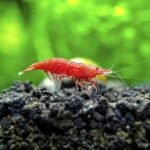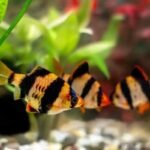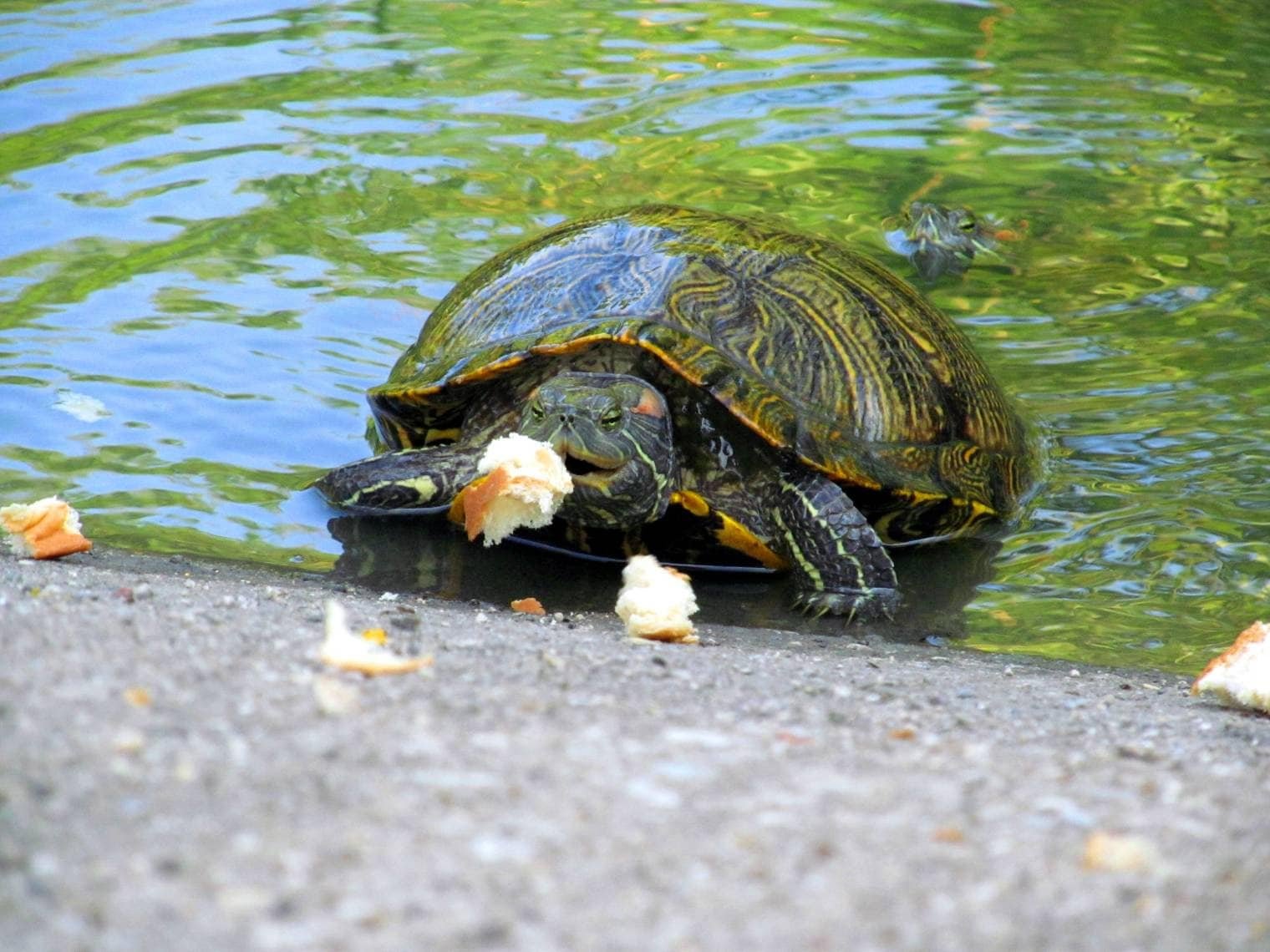Denison barb(aka Roseline Sharks), torpedo barb, Red-line Torpedo Barb, or simple Sahyadria denisonii are some names of cyprinid species endemic to the states of Kerala and Karnataka in southern India, inhabiting fast-flowing rivers and mountain streams of the Western Ghats. It is commonly seen in the aquarium industry. It is a highly peaceful fish species, despite its quick movements and relatively large size. The commercial exploitation of the species for aquarium purposes has placed it in the position of an endangered species. They are very active fish when in the right tank conditions.
Species Overview
Denison’s barb is a torpedo-shaped fish up to 6 inches in length. It is also known as Red Line Barb, Red Lined Torpedo Barb, Barb Miss Kerala Roseline, Shark Torpedos. They are usually silver in color with a bright red line on the first half of the body and the dorsal fin. This species is classified as a type of barb.
Introduction
Denison Barb is a tropical fish species relatively new to hobby and science. It is native to southwestern India and has a marked red line running from the eye to the fish’s midsection; this line also runs along the front of the dorsal fin. Underneath the red line, they present a black stripe, running along the entire side of the body in its midline. As the fish matures, the grayish-green color starts to appear on the skin. Overfishing caused by the high demand for fishkeeping led to the almost disappearance of these barbs in the wild. Pollution, growth of populated areas, and deforestation are among the other causes for the decline in the population of Denison barb. Adult male fish can easily reach 6 inches and require large tanks with enough space for a school to swim freely.
Origin and distribution
It was first described in 1865 as being endemic to the states of Kerala, and southern Karnataka in southwestern India, often called the Malabar Coast. They live in shoals, in streams, lakes, and rivers that have dense vegetation and rock formations, with water rich in oxygen. Overfishing is a critical factor in suppressing wild populations. Efforts have been made to combat this by instituting periods when collection cannot be permitted and commercial breeding programs in East Asia and Southeast Europe. However, the species remains endangered and on the IUCN Red List.
Introducing Denison Barb
In adulthood, the Denison barbs are 4.3 to 6 in long. In the wild, this tropical fish lives in lakes, streams, and rivers with a strong water flow. You will need to replicate the fish’s natural habitat in an aquarium by providing a filtration system with high-flow pumps. Denison barbs live in large schools and are peaceful fish.
Colors and markings
Long and torpedo-shaped, you can easily see the reasons why some call it the Redlined Torpedo Barb. The silver body is separated by a black line that runs throughout the body, from muzzle to tail. The dorsal and caudal fins are also bright red; the caudal end is streaked with grey. Mature specimens are known to produce a greenish color on the head. Recently, a golden variant was developed by breeders, it has the classic red stripes of these barbs, but it cannot match the black line of the wild variety. It can reach 15 centimeters in length and can be found in almost any aquarium store globally.

Caring for Denison barber
Denison Barbs react exceptionally well with the life at the aquarium. These fish are not considered suitable for novice amateurs, but this is more linked to the fact that they need large spaces, as the Denison’s Barb is exceptionally resistant and adaptable.
Origins of Denison barbarian
Denison Barb hails from southwestern India; its modern distribution is highly fragmented, with small populations remaining in the Valapatanam, Chaliyar, Kallar, Karyangod, Kuttiyadi, Chandragiri, Sully, Kuppam, Iritti, Anjarakandipuzha, Bhavani, and Bharatapuzha river systems. The Roseline shark is a victim of its popularity. Because of overexploitation due to its high demand, combined with increasing pollution and deforestation destroying its natural habitat, it is listed as an endangered species on the IUCN list. Most of the Denison barb you can now buy comes from Kerala (Calicut) in India. In recent years, measures to combat these problems have included periods when the fish collection is not allowed, along with encouraging commercial breeding programs in different parts of the world.
Denison Barb Habitat and Care
As the Denison barb overgrows and becomes relatively large, it needs large tanks with a capacity of over 55 gallons. The tank should be extended, providing all the space necessary for the school to swim freely in open areas. You can use rocks and driftwood to create hideouts and caves. Their temperature range is vast; they are collected in places where the water has low temperatures, around 59 F, going up to 77 F. These fishes do not tolerate Nitrogen and organic matter in the water very well, so regular water changes. Tank sanitation is essential to maintain the health of this species. This species needs high levels of oxygen and pure water. The main success factor for keeping the species, besides the water, is always clean is the space in the tank.
Denison Barb fish profile – care feeding breeding and care
Denison Barb is a hardy species that performs well if kept in schools with at least six individuals. It requires large tanks measuring 55 gallons or more.
Origin and appearance
Denison barbs prefer fast-moving waters, rivers with rocky and muddy banks, and substrate with dense vegetation to hide within. Its coloration against a silver body has a red band up to the middle of the body, underneath it has a dark bar that runs the length of the fish. Its lifespan can be up to 5 years, as long as the species is well maintained.

Colors and marking
Sahyadri denisonii is a silverfish with a black lateral line running from snout to tail. In contrast, a bright scarlet line runs parallel to the black stripe that extends to the mouth through the fish’s eyes. The scarlet line continues to the center of the body. Recently, various species have appeared with a golden body and without the typical black band of the wild type. Sahyadri uses two “barbels” to find food. The adult Deniso’s tail and front are also bright scarlets.
Denison Barb Care Guide
A 55-gallon horizontal aquarium is a minimum size to hold a group of six Denison barb. If you want to build larger schools, you need a much larger aquarium. Keep water pH at 6.5-7.8 and hardness at 90 to 447 ppm. The ideal temperature range is 59°F to 77°F. They like well-lit tanks.
Maintenance
Denison barb will thrive in environments with lots of plants or in forest streams. You can use a high-tech system in densely planted environments, as these fish live quietly in well-lit environments. This second comprises a soft clear substrate, root trunks, and leaf debris, with the lighting tending to low. You can also add aquatic plants that can survive under such conditions as Microsorum, Taxifyllum, or Cryptocoryne.
Water parameters
The temperature inside the tank should be around 68 degrees Fahrenheit. This temperature is a little below the typical tropical environment. The pH of the water should range between 6.5 and 7.8. Regular tank cleaning is essential as these fish do not tolerate high levels of pollutants or organic matter. It is not a typical barb for the beginner, but if the water in the aquarium is always in ideal condition and the size of the tank is adequate, there should be no problems.
Filtration
As mentioned earlier, in addition to correctly and efficiently sizing biological and mechanical filtration to remove particulates and pollutants, Denison barbs need a fast-flowing stream to be comfortably maintained. It’s a good idea to use an extra pump to keep the water moving and stimulate gas exchange in your tank.
Tank Size
Do not use any small aquarium. A 50-gallon tank is a minimum needed to keep a small group. Hiding spots such as logs and rocks are valuable additions to the pond, as are live plants. Plants that are easily uprooted are not recommended, so choose harder and more resistant plants; make sure they are well anchored. An extra pump is welcome to ensure continuous and even water circulation.
Tank size and habitat
Denison barb lives in rocky Indian underwater habitats with dense vegetation. A tank with little decoration and no places to hide is not recommended, as the fish can feel stressed. Although not territorial, they are fast and highly active swimmers, especially during feeding. When choosing a substrate for the aquarium, use sand or gravel; use stones without edges and pebbles of different sizes for an aesthetic effect.
Denison Barb Tank Mates
Denison barbs are best kept in schools of 6 or more for comfort. Great tank mates you can include are other pacific barbs, large size tetras, cichlids, and rainbow fish are compatible. When maintained with ample area, excellent tank mates, a school of at least six species, and the correct water standards, you will have no problem keeping Denison Barbs.
Sexual differences
Adult Denison barb females tend to be a little smaller, have a heavier body, and are sometimes much less colorful than adult males.
Denison Barb Breeding
In the wild, the breeding season for Denison barbs is October to March. There are some reports of spawning in home aquariums, but they are still rare. There are commercial reproduction programs, and there are still few scientific articles addressing their reproduction, but those published are of significant impact.
Breeding
The process for creating them is complex and not suitable for the average home hobbyist. The induced developmental process involves manipulating water chemistry, complex feeding regimens, and the use of hormones. Fish breed in the wild from October to March. These times vary from river to river.
Denison Barb Diet
Denisons are omnivorous fish with varied tastes. Offer them a mix of meaty treats such as shrimp, daphnia, cyclops, and bloodworms. You should also include the vegetable matter in the diet, and you can also add fresh vegetables, algae, and spirulina wafers to your diet.
Diet and feeding Denison Barb
Denison Barb is an omnivorous species and must enjoy multiple food sources for optimal health. Live, fresh food is excellent. In addition, spirulina, seaweed, and even vegetables are welcome. For optimal health, you should feed them an extensive range of meat-based ingredients and vegetarian foods.
Diet
Wild Denison barbs are likely for vegetables, small insects, crustaceans, worms, and other zooplankton. Keeping it at an adequate number will make the fish much more confident and produce a more natural appearance in the school.
Final thoughts
The Denison Barb, a beautiful fish of Indian origin, is an excellent choice for long-time aquarists. You will need a layout that resembles a natural river or mountain stream environment with milder conditions and a strong water flow to keep the active Denison barb happy. Fish have characteristic red lines and sides to create spectacular displays and require a lot of space to swim. This species is best suited for an aquarist with a large tank with plenty of room to swim in a natural river environment or a mountain stream with cold and robust conditions.






![Top [2023] 10 Best Aquarium Backgrounds for Types of Tanks Top [2023] 10 Best Aquarium Backgrounds for Types of Tanks](https://aquariumhunter.com/wp-content/uploads/2021/03/Fish-Tank-Background-600x300.jpg)
